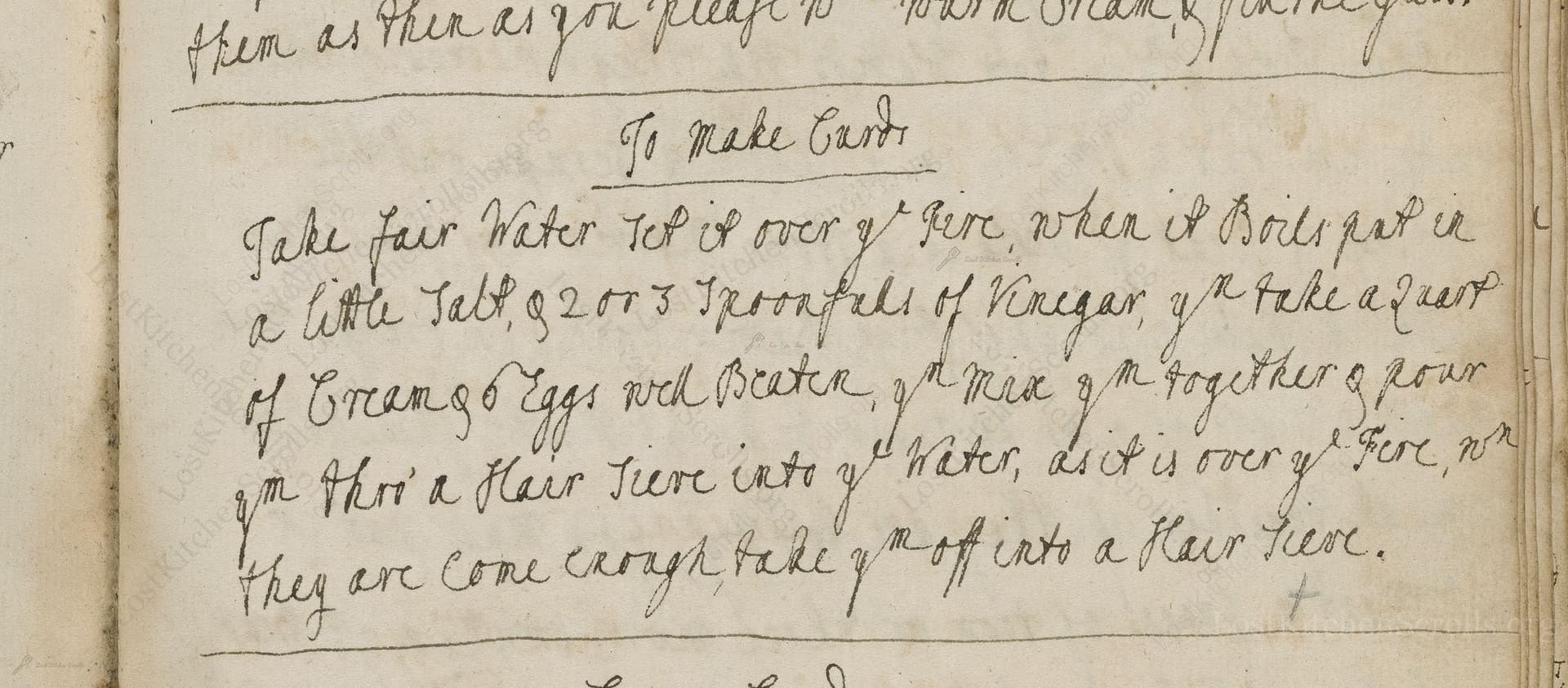
To Make Curds
"Take fair Water Set it over ye Fire, when it Boils put in a little Salt, & 2 or 3 Spoonfuls of Vinegar & take a quart of Cream & 6 Eggs well Beaten, & mix yt together & pour ym thro' a Hair Sieve into ye Water, as it is over ye Fire, & ym they are Come enough take ym off into a Hair Sieve."
Note on the Original Text
This recipe is a beautiful example of mid-Georgian kitchen notation—direct, concise, and meant for an audience already familiar with household routines. Older spelling is often phonetic: note 'yt' (that), 'ym' (them), and 'ye' (the). Procedures are condensed, assuming knowledge of timing and technique. Eggs and cream are the bulk of the curd, set by both heat and the acid from vinegar, creating a delicate dairy treat without modern rennet or commercial starter cultures.

Title
Receipt book of Elizabeth Smith (1775)
You can also click the book image above to peruse the original tome
Writer
Elizabeth Smith
Era
1775
Publisher
Unknown
Background
Step into the refined kitchens of the late 18th century with Elizabeth Smith, whose culinary wisdom offers a charming taste of Georgian elegance and time-honored recipes to delight any palate.
Kindly made available by
Folger Shakespeare Library
This recipe hails from the late 18th century, found within the handwritten collection of Elizabeth Smith, who flourished in the latter half of the 1700s. At this time, the making of curds was a practical art in English households, predating wide access to commercially produced cheeses and yogurts. Recipes like this one offered both a sweet dish and a means of preserving dairy, often enjoyed with sugar or fruit as a dessert or treat. Housewives and cooks prized such receipts (as they called recipes) for their thrift and reliable results.

In its day, this curd recipe would have required a large hearth pot or kettle to boil the water, a wooden spoon for stirring, and a hair sieve—a fine strainer made from horsehair, prized for its delicate filtration. Eggs would have been beaten with a whisk or fork in a large bowl, likely earthenware. Today, a stainless steel saucepan, metal or plastic whisk, and a fine-mesh sieve or cheesecloth make fine substitutes.
Prep Time
10 mins
Cook Time
20 mins
Servings
8
We've done our best to adapt this historical recipe for modern kitchens, but some details may still need refinement. We warmly welcome feedback from fellow cooks and culinary historians — your insights support the entire community!
Ingredients
- 4 1/4 cups water
- 1/4 teaspoon salt
- 2–3 tablespoons vinegar (white wine vinegar or cider vinegar)
- 4 1/4 cups heavy cream (double cream)
- 6 large eggs
Instructions
- Bring 4 1/4 cups of water to a boil in a large pot.
- Add a pinch of salt (about 1/4 teaspoon) and 2 to 3 tablespoons of vinegar.
- In a separate bowl, beat together 4 1/4 cups of heavy cream and 6 large eggs until well combined.
- Pour this mixture slowly through a fine-mesh sieve into the boiling water, stirring gently as you go.
- Let the curds form over medium heat—do not let it boil vigorously.
- When the curds separate and thicken, remove them from the heat and pour them through a sieve or cheesecloth to drain.
- Allow the curds to cool and set before serving.
Estimated Calories
350 per serving
Cooking Estimates
It usually takes 10 minutes to prepare the ingredients and about 20 minutes to cook the curds. This recipe makes about 8 servings, and each serving has around 350 calories.
As noted above, we have made our best effort to translate and adapt this historical recipe for modern kitchens, taking into account ingredients nowadays, cooking techniques, measurements, and so on. However, historical recipes often contain assumptions that require interpretation.
We'd love for anyone to help improve these adaptations. Community contributions are highly welcome. If you have suggestions, corrections, or cooking tips based on your experience with this recipe, please share them below.
Join the Discussion
Rate This Recipe
Dietary Preference
Main Ingredients
Culinary Technique

Den Bockfisch In Einer Fleisch Suppen Zu Kochen
This recipe hails from a German manuscript cookbook compiled in 1696, a time whe...

Die Grieß Nudlen Zumachen
This recipe comes from a rather mysterious manuscript cookbook, penned anonymous...

Ein Boudain
This recipe comes from an anonymous German-language manuscript cookbook from 169...

Ein Gesaltzen Citroni
This recipe, dating from 1696, comes from an extensive anonymous German cookbook...
Browse our complete collection of time-honored recipes



